- Products
- Solutions
- Developers
- Support
- About
In this post we’ll be highlighting the different steps required to get the DOTS Global Address Complete service up and running in a sales force lightning component. Lightning components are a quick and easy way to customize your Salesforce experience. They allow developers to create custom layouts and functionality for their users. DOTS Global Address Complete is a perfect pairing for lightning components; it provides some heavy lifting in finding the intended address that a user enters without having to type out all the fields. Additionally, the DOTS Global Address Complete service provides validation for US addresses so you can get extra insight on the mailability of a user entered address. To follow along with this tutorial you will need the following:
Salesforce is a massively popular cloud-based CRM solution. Salesforce is also extremely extensible which makes it a great pairing with Service Objects products. Additionally, DOTS Global Address Complete can help speed up filling address information. For example, if you have someone taking customer addresses over the phone, having DOTS AC fill in an address as a user types can help speed up data input.
The first step will be to add the Service Objects DOTS AC endpoint. This will ensure the lightning component can successfully call the Address Complete service. To do this select the “Setup” option under settings icon in the right hand corner.
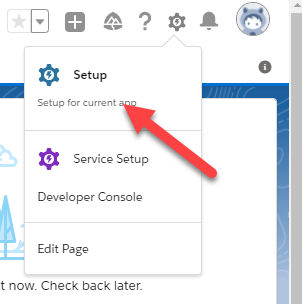
In the search bar, search the text “CSP” and then select “CSP Trusted Sites”. On the resulting page select the “New Trusted Site” button. On the resulting page fill in the following information:

Then click “Save”
Note: If you are using a trial key, the Trusted Site URL should be trial.serviceobjects.com but if you are using a production key, the URL should be sws.serviceobjects.com. You can simply add both URLs at this point for the ease of integration when you transition from a trial to a production key.
For this step, head to the developer console. This can be accessed through the same settings menu that was used to add the CSP in the previous step.
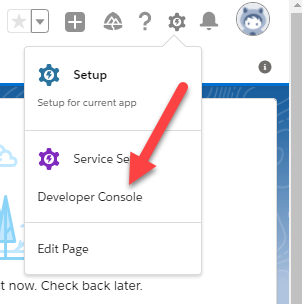
From here, select File, New, and then Lightning Component. Give your lightning component a proper name and select ok.
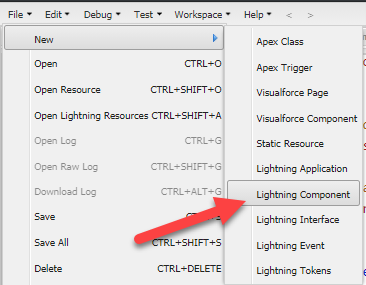
Congrats! You’ve created a lightning component. Well sort of, lets add some code to the component so that we can being calling the service.
<aura:component implements="force:appHostable,flexipage:availableForAllPageTypes,flexipage:availableForRecordHome,force:lightningQuickAction" access="global" controller="GAC">
<!-- Here we can initialize all the values we will want the DOTS Address Complete service to to populate -->
<aura:attribute name="address1" type="string" default=""/>
<aura:attribute name="city" type="string" default=""/>
<aura:attribute name="state" type="string" default=""/>
<aura:attribute name="zip" type="string" default=""/>
<aura:attribute name="country" type="string" default=""/>
<!-- This List will hold all the prediction values for the service. -->
<aura:attribute name="predictions" type="List" default="[]"/>
<h3>DOTS Global Address Complete Demo</h3>
<!-- This will be the lighting input for our address1 field, when a user types into this field, the page will call the getAddressSuggestions method in the controller -->
<lightning:input label="Address 1"
name="address1"
aura:id="address1"
value="{!v.address1}"
onchange="{!c.getAddressSuggestions}" />
<br/>
<!-- This will hold the predictions that the DOTS Address Complete Service Returns. If a user selects an address, it will call the getSelectedDetails method of the controller -->
<div class="suggestions">
<aura:if isTrue="{!v.predictions.length > 0}">
<ul class="city_predictions" style="z-index:99">
<aura:iteration items="{!v.predictions}" var="prediction" indexVar="index">
<li class="slds-listbox__item">
<a class="predicted_address" onclick="{!c.getSelectedDetails}" data-row-index="{!index}">{!prediction.Prediction} - {!prediction.Extra}</a>
</li>
</aura:iteration>
</ul>
</aura:if>
</div>
<!-- These are the rest of the input fields that the service will fill in. This is just a starting point to demo the service. Please review the documentation for the service to determine which fields would be best for your applicaiton -->
<!-- https://docs.serviceobjects.com/display/devguide/AC+-+Address+Response -->
<div class="address-inputs">
<lightning:input label="City"
name="city"
aura:id="city"
value="{!v.city}"
style="z-index:-1"/>
<br/>
<lightning:input label="State"
name="state"
aura:id="state"
value="{!v.state}" />
<br/>
<lightning:input label="Zip Code"
name="zip"
aura:id="zip"
value="{!v.zip}" />
<br/>
<lightning:input label="Country"
name="country"
aura:id="country"
value="{!v.country}" />
</div>
<!--This would be a great spot to put in some extra elements that may do something with the autocompleted values. I.e. add a record to the crm, update an address etc -->
</aura:component>
Here’s a couple things to note about the front end component

Now that the visual part of our lightning component is in place, we’ll add the javascript that will handle the functions we defined in the previous step. Below is the component controller code and the helper code that we’ll use.
DOTSGlobalAddressCompleteController.js
({
//This function will return an array of predicted addresses based on the user input
getAddressSuggestions : function(component, event, helper){
var input = component.get('v.address1');
//Only search for predictions if the input isn't null or empty
if(Boolean(input)){
var params = {
"input" : input
}
//Call the getSuggestions function in the GAC controller. If there are predictions, we'll set the array of addresses returned to the v.predictions list in the component
helper.callServer(component,"c.getSuggestions",function(response){
var resp = JSON.parse(response);
component.set('v.predictions',resp.Addresses);
},params);
}
//If no predictions are returned, v.predictions will be set to an empty list
else{
component.set('v.predictions', []);
}
},
//This function will get additional details about an address that a user clicks.
getSelectedDetails : function(component, event, helper){
var selectedItem = event.currentTarget;
//Get the Index of the selected address so we know which one the user pixed.
var index = selectedItem.getAttribute("data-row-index");
//Pull back the user's selected address
var selection = component.get('v.predictions')[index];
var addressType = selection.AddressType;
var placeid = selection.Id;
var params = {
"placeId" : placeid
}
//If the address type is BuildingNumber, then we'll call the getUnits method to return all the available units for an address
if(addressType == "BuildingNumber"){
helper.callServer(component,"c.getUnits",function(response){
var buildingDetails = JSON.parse(response);
component.set('v.predictions', buildingDetails.Addresses);
}, params);
}
else
{
//If the user selected a regular address, then we'll call the getDetails function of the GAC controller which will get additional details about the users selected address
helper.callServer(component,"c.getDetails",function(response){
var placeDetails = JSON.parse(response);
//This where we do the "autofill" and set the input form values to the values the service found on the use selected address
component.set('v.address1',placeDetails.AddressInfos[0].Address1);
component.set('v.city',placeDetails.AddressInfos[0].Locality);
component.set('v.state',placeDetails.AddressInfos[0].AdminArea);
component.set('v.zip',placeDetails.AddressInfos[0].PostalCode);
component.set('v.country',placeDetails.AddressInfos[0].Country);
//Set the predictions List to an Empty Array
component.set('v.predictions',[]);
},params);
}
}
})
DOTSAddressCompleteHelper.js
({
//This will call our GAC class that will make the actual call to the address complete web service.
callServer : function(component,method,callback,params) {
var action = component.get(method);
if (params) {
action.setParams(params);
}
action.setCallback(this,function(response) {
var state = response.getState();
if (state === "SUCCESS") {
// pass returned value to callback function
callback.call(this,response.getReturnValue());
} else if (state === "ERROR") {
// generic error handler
var errors = response.getError();
if (errors) {
console.log("Errors", errors);
if (errors[0] && errors[0].message) {
throw new Error("Error" + errors[0].message);
}
} else {
throw new Error("Unknown Error");
}
}
});
$A.enqueueAction(action);
}
})
DOTSGlobalAddressComplete.css
.suggestions.THIS {
z-index:1 !important;
font-size: 15px;
background-color: white;
margin-top: -19px !important;
border-radius: 5px;
position: absolute;
border-width: thin;
border-color: #a9a0a0;
border-style: solid;
padding-left: 12px;
padding-right: 12px;
}
.address-inputs.THIS{
z-index:-50!important;
}
A couple things to note about the code above:
This is where we will create the server side apex class that will call out to the DOTS Global Address Complete service. To do this, head over to the developer console and select File, New, and then Apex Class.
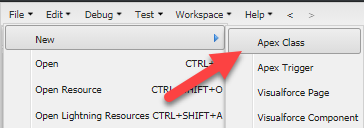
Enter a name for the Apex class and select “OK”. We’re simply going to call ours GAC. In the newly created Apex class, we’ll put the following code:
public class GAC {
@AuraEnabled
//This function calls the "Predict" endpoint which will return a list of address suggestions based on the user input
//Right now this function is biased towards USA address with the query option '&bl=USA' feel free to remove the location or add to it.
public static string getSuggestions(String input) {
String url = 'https://trial.serviceobjects.com/AC/Predict?id='+getKey()+'&q='+EncodingUtil.urlEncode(input, 'UTF-8')+'&bl=&al=&l=7&pl=en';
String response = getResponse(url);
return response;
}
@AuraEnabled
//This gets the detailed information about the address the user selected. This result will have the parsed out info from the service.
public static string getDetails(String placeId) {
String url = 'https://trial.serviceobjects.com/AC/Select?id='+getKey()+'&q=' + EncodingUtil.urlEncode(placeId, 'UTF-8');
String response = getResponse(url);
return response;
}
@AuraEnabled
//This function gets all the possible unit numbers for addresses that have multiple unit numbers
public static string getUnits(String placeId) {
String url = 'https://trial.serviceobjects.com/AC/Units?id='+getKey()+'&q=' + EncodingUtil.urlEncode(placeId, 'UTF-8') + '&bs=USA&al=&l=7&pl=en';
String response = getResponse(url);
return response;
}
//Makes a Simple HTTP GET request
public static string getResponse(string strURL){
Http h = new Http();
HttpRequest req = new HttpRequest();
HttpResponse res = new HttpResponse();
req.setMethod('GET');
req.setEndpoint(strURL);
req.setTimeout(120000);
res = h.send(req);
String responseBody = res.getBody();
return responseBody;
}
//Gets the LicenseKey for the service call
public static string getKey(){
string key = 'YourLicenseKeyHere';
return key;
}
}
Here’s a few things to keep in mind about this code.
To start head back to setup page and search Lightning App Builder in the search bar as shown below
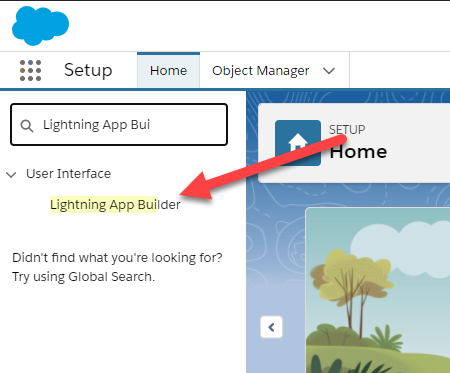
On the resulting page either select “New” to create a new page or Edit on one of the existing pages. For examples sake, we will just add a component to the existing home page. In the Lightning App editor you should now see the component we just created under the “Custom” section of the list of components.
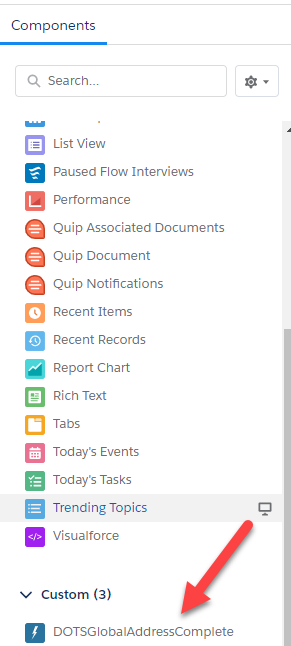
To add this to a current page, simply drag and drop it to an open pane in the component section and then click save! If you are creating a new page you will have to activate the page first. Now we’re ready to test out our new component!
Now it is time to see the service in action! Head over to the page or app where the new component was added. We will use the Service Objects office address as an example:
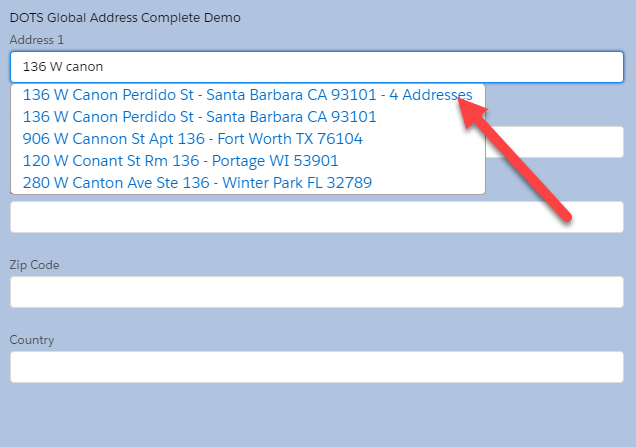
Notice the text “4 Addresses” next to the first suggestion. This tells us that there are 4 unit numbers at this address to choose from. If we select any of the non-apartment addresses, the values on the form should be automatically filled out:
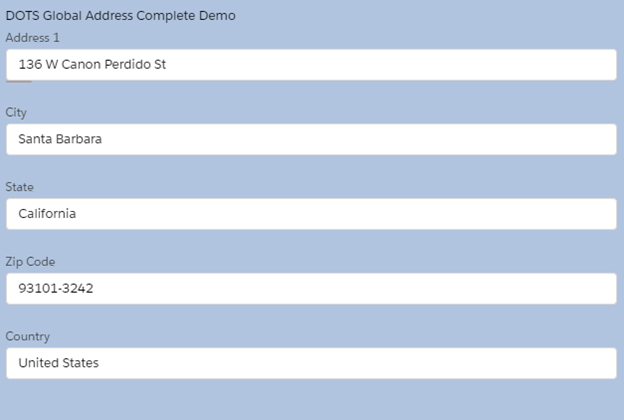
Viola! You now have a working DOTS Global Address Complete demo in your salesforce instance.
Troubleshooting Tips and Tricks
While it may take a small bit of work to get DOTS Global Address Complete integrated into your Salesforce instance, it is most definitely worth it! This product is a great user-friendly time save when entering address information into a CRM and can help your salesforce users get the most out of the product. Get your free trial key today and start using it in your Salesforce instance!
Thanks for following along in our tutorial!
Salesforce CRM and Service Objects APIs are a great pairing to enrich and validate your customer and lead data. You can get started by downloading our sample code and signing up for a free trial key for the Global Address Complete service. For further assistance integrating any of our Customer Data Validation services with a Salesforce workflow rule, feel free to contact one of experts at support@serviceobjects.com.







© 2025 Service Objects, Inc. All rights reserved.